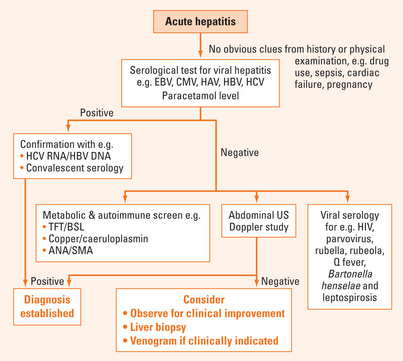Chapter 34 ACUTE HEPATITIS
GENERAL CONSIDERATIONS
Most cases of acute hepatitis are caused by viral hepatitis. Systemic infections such as pneumonia are also commonly associated with non-specific and reactive hepatitis. A smaller cohort is associated with drugs, vascular abnormalities, metabolic disturbance, autoimmunity, pregnancy and systemic illness, such as cardiogenic shock and metabolic disturbance (Table 34.1). However, in fulminant hepatic failure or subfulminant hepatic failure, drugs can become a dominant cause of acute hepatitis. The scope of this chapter will focus primarily on acute viral hepatitis.
TABLE 34.1 Differential diagnoses of acute hepatitis
| Viral hepatitis | Systemic infections |
| Drugs | Metabolic |
| Autoimmunity | |
| Vascular | Pregnancy associated conditions |
CLINICAL PRESENTATION
The clinical spectrum of acute hepatitis may range from mild symptoms and signs (Table 34.2) associated with recent onset of liver enzyme abnormalities to fulminant hepatic failure. Most symptoms and signs are non-specific (Table 34.2) though there are some manifestations associated with specific conditions, and if present, are helpful in differential diagnosis (Table 34.3).
TABLE 34.2 Non-specific symptoms and signs of acute hepatitis
TABLE 34.3 Diagnostically helpful associations of acute hepatitis
| Infectious mononucleosis | Hepatitis C |
| Metabolic disturbance | |
| Hepatitis B | Drugs |
DIFFERENTIAL DIAGNOSES
A diagnostic algorithm is suggested for assessing a patient presenting with acute hepatitis (Figure 34.1). There may be obvious clues at the outset such as pregnancy, history of paracetamol overdose or recent drug use. Serology for common causes of viral hepatitis and paracetamol level should be requested as initial investigations. Failing to identify an obvious cause, other less common causes would need to be considered and liver biopsy may be necessary.
Acute viral hepatitis
The most common cause of acute hepatitis found on audits of consecutive presentations to the emergency department is hepatitis B, followed by hepatitis A and C (Table 34.4). History of travel, family contacts, immunocompetency, blood transfusions, intravenous (IV) drug usage, sexual practice, tattoos, body piercing, birthplace and prior vaccination can provide useful information for differential diagnosis.
TABLE 34.4 Prevalence of acute viral hepatitis
| Western countries | |
| Acute hepatitis B | 30%–60% |
| Hepatitis A | 25%–50% |
| Acute hepatitis C | 15%–20% |
| EBV hepatitis | 2%–10% |
| Hepatitis G | 1% |
| CMV hepatitis | 1%Stay updated, free articles. Join our Telegram channel
Full access? Get Clinical Tree
 Get Clinical Tree app for offline access
Get Clinical Tree app for offline access

|






